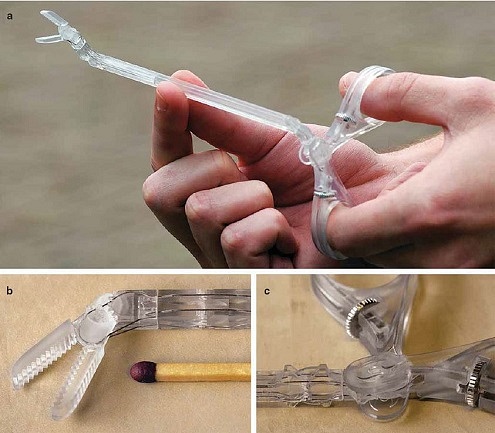Biomechanical engineer Dr. Filip Jelínek has designed two new medical devices – one for identifying and sampling cancerous tissue; the other, a surgical instrument that can be produced on a 3D-printer.
As keyhole (or minimally invasive) surgery becomes more popular, there’s a growing need for more precise but less invasive surgical tools. Currently a surgeon uses at least two different instruments for detecting and removing a sample of potentially cancerous tissue for analysis. So, as part of his PhD thesis, Jelínek, at the Faculty of Mechanical, Maritime and Materials Engineering at TU Delft, designed a prototype for one device that would do both these things.
Inspired by a sea urchin’s mouthparts, an organ known as Aristotle’s Lantern, Jelínek devised a biopsy harvester that has a crown-shaped collapsible cutter. This design allows the surgeon to detect, remove and analyse a sample of tissue faster and more precisely than before. If the biopsy reveals cancerous cells, the surgeon can then immediately cut out all the affected tissue, precluding the need for another operation.
As well as the biopsy harvester, Jelínek (in collaboration with Dr. Paul Breedveld and Rob Pessers, MSc) also developed a surgical instrument prototype that looks like a pair of scissors that can be manufactured almost entirely by a 3-D printer. DragonFlex is an easily steerable instrument that enables the surgeon to access to tissues lying behind e.g. other organs, without having to make another incision. “From the clinical point of view”, said Jelínek, “the most important point is that the joint construction is stiff enabling full and accurate control.”
Because DragonFlex has few components and no rivets, pins or screws, the manufacturing and assembly costs are low. It can therefore be marketed as a disposable (single use) instrument rather than a reusable one which needs sterilizing every time it’s used. According to Jelínek, the development of this prototype shows that even seemingly complex mechanisms can be cleverly redesigned if the manufacturing technology enables it. “Using 3-D printing is changing the way TU Delft researchers design”, he said.



Comments are closed.